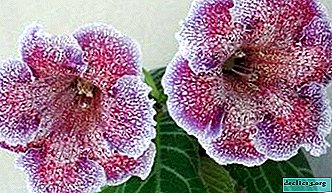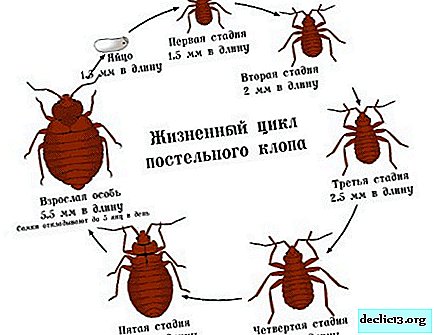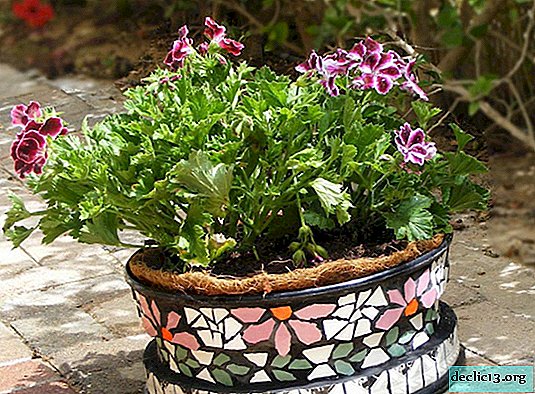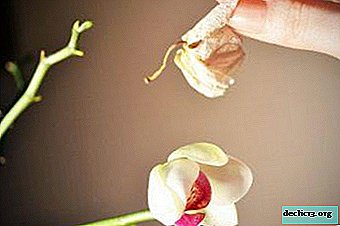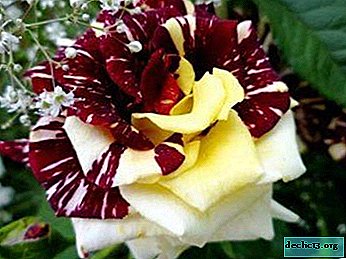Everything about the rose Novalis: description and photo, cultivation and care, nuances of transplantation and other features of the variety
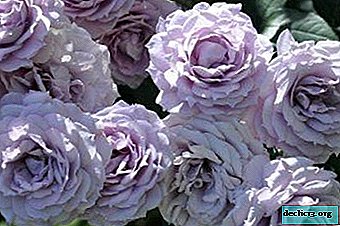
Most recently, in 2010, breeders managed to bring out a sky-blue rose. The flower was called novalis rose. The rose is not only remarkable for its unusual color, but also for its large, tight buds.
In this article, you will learn how to properly care, propagate, prune and transplant the Novalis rose. And also we will tell you what diseases and pests can affect this flower and what measures must be taken to preserve it.
Description and photo
Rosa Novalis belongs to the class of floribunda. The color of the goblet bud is dark purple, the flower itself in full dissolution is pale lilac. Withering petals turn gray. The size of the flower is 8-10 cm, the number of petals reaches 60. The bush itself is dense, shoots are looking vertically. Width can reach 80 cm, and height - 90 cm.
In the photo you can see how the flower looks.





Advantages and disadvantages
The advantages of Novalis include:
- Unpretentiousness in leaving.
- Undemanding to the choice of soil.
- Good adaptation to various climatic conditions.
- Long flowering.
- Resistance to diseases and pests.
- Frost resistance.
- Drought tolerance.
A minus of a rose is its weakly expressed aroma.
Characteristic
Flowering is long, continuous. High resistance to powdery mildew and black spotting. The variety is frost-resistant, withstands up to -23 ° C. Resistance to rain is average.
History of occurrence
Rose named after the poet George Philipp Friedrich von Gardenberg, representative of early romanticism in Germany. The poet had the pseudonym "Novalis", which in Latin means "he who cultivates new, virgin lands". The blue flower in the work of Novalis is a symbol of an unattainable ideal. In 2010, the breeders of the German company Cordes bred a new variety of floribunda roses. It was called Novalis.
Difference from other species
- Floribunda (and Novalis, as a representative of the class) differs from other types of roses in the size of their buds.
- The stem of Novalis has many inflorescences.
- Novalis blooms continuously.
- Quickly recovers after frost damage.
- It can be grown in the garden and in the pot.
Bloom
When does it bloom?
Rose is re-flowering. It blooms profusely and continuously throughout the season. The beginning and end of flowering depends on climatic conditions. The bud has up to 40-60 petals. Rosette-shaped flowers can be collected in inflorescences of two or three buds, or appear alone.
Care before buds
 Flowering is promoted by spring pruning. Before flowering, pink bushes are watered with a solution of sodium humate (2 l under the bush). The proportion of the solution is 1 tablespoon per 40 liters of water. After the first flowering, mineral fertilizers with trace elements are applied.
Flowering is promoted by spring pruning. Before flowering, pink bushes are watered with a solution of sodium humate (2 l under the bush). The proportion of the solution is 1 tablespoon per 40 liters of water. After the first flowering, mineral fertilizers with trace elements are applied.
During spring planting, the rose is not allowed to bloom, all buds are torn off, directing all the flower's forces to the formation of the root system and the development of the bush itself. Only closer to the fall leave a few buds (1-2 on each shoot), right up to the ripening of the fruits. This helps the rose bush to wintered safely.
Care after flowering
Faded flowers are removed. Cut off above a strong kidney by 5-7 cm. The kidney should have a developed leaf, be deployed on the outside of the bush.
What to do if it does not blossom?
Rose may not bloom for the following reasons.:
- Incorrect landing site (poorly lit, very thick).
- Competition of neighboring plants. Some plants inhibit the rose, for example, lilac, mock orange.
- Incorrect pruning. In spring, you can not carry out strong pruning, only light pruning, cutting off the tops of the shoots on a strong bud.
- Wilted flowers are not removed.
Use in landscape design
Novalis can be used in the design of any style. These roses make beautiful hedges, they make out garden paths and borders. Planted in a pot Novalis will decorate the gazebo or porch. A single lush bush will look luxurious on a green lawn.
Growing
Site selection
Correct site selection conditions:
- Illumination.
- Shade.
- Non-crowdedness.
- The proximity of groundwater.
Timing
The most favorable time is from mid-April to the end of May. In a warmer climate, planting events can be carried out in the fall in September and October. A planted plant in autumn will have time to take root before frost.
What should be the soil?
The soil should be fertile, loose, with neutral acidity. Clay soil is mixed with river sand, compost. Bone meal and superphosphate (40 g per hole) are added. If the soil on the site is sandy, add clay soil with humus. To reduce the acidity of the soil, wood ash or dolomite flour is introduced. For acidification using manure or peat.
Landing Methods
 A rose can be propagated in several ways:
A rose can be propagated in several ways:
- The seeds.
- Cuttings.
- Wrapped.
For Novalis, suitable propagation methods are by cuttings and grafted seedlings.
When choosing seedlings, you need to decide whether to give preference to grafted or root crops. If the seedling is grafted, it is necessary to find out on which rose, what characteristics of the stock. It is better to choose a seedling, the age of the roots of which is one year, and the stock is annual. Such a seedling will have at least three shoots.
Seedlings can be with open or closed root system. In the case of an open system, care must be taken so that the plant is recently dug up, the roots are not damaged. There should be no spots on the leaves, the bark is smooth, without damage. If seedlings are bought in spring, the buds should be at rest. Seedlings bought in the fall can be stored until spring planting in the basement with dug wet sand. Before planting, damaged roots are removed, all roots are cut to 30-35 cm. The color of a healthy root cut is cream.
Temperature
Plants are planted in open ground when the earth warms up to a depth equal to the height of an earthen coma on the root system of a seedling. Gardening can begin at an air temperature of 0 to 7 degrees.
The optimum soil temperature for planting roses is 10-12 ° C.Watering
Around the bush make an earthen rampart, which will prevent the spread of fluid. Novalis is poured with warm, settled water onto each bush in a bucket of water. When watering, the foliage is not affected. Do not water in the heat. Watering frequency - once a week, in dry weather - twice. By the fall they stop watering, the bushes should have enough precipitation. The exception is the southern regions, where September is another summer month.
Top dressing
Top dressing begins to make from the second year of life of the plant. The composition of the necessary mineral fertilizers will vary depending on the period of development of the flower.
- The time of budding and flowering is nitrogen fertilizing.
- In the fall - phosphorus-potash fertilizers.
Weeding
Weeding is carried out in dry weather so that weeds dry faster.. Weeds must be tackled, as they take nutrients and moisture.
Loosening
Immediately after the first pruning, spring cultivation is carried out. Loosening is necessary shallow (not deeper than 10 cm) so as not to damage the roots.
Mulching
Before mulching, weeds are removed, the plant is watered. The thickness of the mulch layer is 4-8 cm. Mulch is not close to the shoots. Peat, compost, rotted sawdust, bark, wood chips can act as mulch for roses. After decaying it is mixed with soil when loosening and the process is repeated.
Pruning
Preventative
 Combined pruning recommended for floribundaeasier for young stems and stronger for old. The main pruning is carried out in the spring after the appearance of the kidneys. Shoots cut over the fifth kidney. This stimulates the rose to bloom earlier.
Combined pruning recommended for floribundaeasier for young stems and stronger for old. The main pruning is carried out in the spring after the appearance of the kidneys. Shoots cut over the fifth kidney. This stimulates the rose to bloom earlier.
Strong pruning is done when you need to rejuvenate an old bush. Branches are cut over the second bud. This procedure promotes the growth of new basal shoots, providing continuous flowering.
Formative
In summer, cut the bush, removing faded flowers and forming a crown. Summer pruning does not allow the appearance of energy-consuming fruits.
Sanitary
In the fall, sanitary pruning is carried out. Remove foliage and unnecessary processes.
Pests
Causes of pests and diseases:
- poor choice of location for the plant (too shady or too damp);
- very densely planted bushes (as a result, poor ventilation of the rosary);
- abnormal weather events (extremely hot summers, or long rains).
Most often, roses suffer from fungal diseases.
Powdery mildew
Powdery Mildew - The Most Common Rose Disease. Symptoms - white powdery coating. The disease contributes to increased humidity. The most dangerous disease for young shoots. Leaves from dew curl and fall. What to do:
- To clear a bush of the struck leaves and stalks.
- Burn them.
- Spray the rose:
- ash solution;
- Mullein
- nettle broth;
- 30% solution of iron sulfate (300 g per bucket of water);
- 2-3% Bordeaux liquid;
- 2-2.5% copper-soap emulsion (500 g of copper sulfate, 1 kg of soap in a bucket of water).

Black spotting
Symptoms are black, brown spots on the leaves. The disease contributes to warm and humid weather, a lack of potassium in the plant. Leaves prematurely turn yellow and fall. What to do:
- Remove and burn leaves affected by spotting.
- Spray bushes with a copper-soap emulsion, 1% Bordeaux liquid, or a decoction of nettle, horsetail.

Rust
Symptoms are rusty tubercles on the stems near the buds, on the upper side of the leaves. The disease develops in spring with high humidity. The leaves turn yellow and fall, the shoots dry out. What to do:
- Tear off and cut off the affected parts of the bush.
- Be sure to burn.
- Treat the bush with a copper-soap solution, 2% Bordeaux liquid, a decoction of nettle (wormwood).
- Inspect the lower surface of the leaf, where spores of pathogen fungi may lurk.

Gray rot
Signs:
- Gray fluffy coating on the ends of stems and leaves.
- The buds do not open and fall.
- Leaves also turn yellow and fall.
The appearance of gray rot contributes to:
- dampness;
- late evening watering.
What to do:
- Remove damaged buds immediately.
- In rainy times, fertilize with manganese.
The most common pests of roses - green rose aphid, leaflet, rose scutellum, spider mite, caterpillars, shedding pennies.

Green rose aphid
- Appears in the spring of whole colonies.
- It multiplies rapidly.
- It affects young shoots, leaves, unopened buds.
- It feeds on the juice of plants, greatly weakening them.
Treatment:
- Insecticides Actellik, Aktara.
- Decoctions of tobacco, pepper, garlic.
Michurin Recipe:
- soap solution;
- a glass of ash and kerosene;
- a little decoction of tobacco.
Spray roses with this solution.

Rose leaflet
From the caterpillars of this butterfly, the leaves curl up in the form of a cigar. Treatment:
- bacterial preparations;
- decoctions of garlic, tobacco and onions.

Rose shield
Small insects that look like flakes-shields that feed on plant sap. Scabies slow down the development of roses, lead to the loss of leaves. They try to remove insects manually, process:
- Actara preparations, Fufanon;
- soap-garlic, soap-onion infusion.

Spider mite
Small arachnids of yellow or brown color. Weave a web on the underside of the sheet. Drought conditions favor spread of mites.
- Affected leaves are burned.
- Bushes are treated with insecticides.

Penny slobbering
Penny larvae drink plant juice, stems weaken, bend, leaves fall off. The lumps of foam in which the larvae live are manually removed or washed with a stream of water from the hose.

Medvedka
A large insect living below the surface of the earth. Damages the roots. Protection - loosening the soil, the use of drugs. Medvedka will leave the site where marigolds will grow.

Breeding
Rosa Novalis propagated by cuttings, which are harvested after the first wave of flowering. Strong young bushes with half-lignified stems are chosen. Cuttings are cut 8 cm long. The upper cut is made straight, the lower - at an angle of 45 degrees. Plants are planted obliquely. The depth of the holes is 15 cm, the distance between the cuttings is 30 cm. The stem is covered with half the ground.
Young plantings are covered with a film before rooting. The film is periodically opened, plants are watered, and the earth is loosened. The first buds are plucked, directing all the forces of the flower to the formation of the root system. Be sure to shelter for the winter.
For a permanent place, the rose bush is transplanted in the third year.Transfer
- A pit for transplantation is prepared in advance. Width - 45-50 cm, depth - 50 cm.
- The upper fertile soil layer is removed.
- At the bottom put a mixture of soil and compost with humus.
- Slices of the roots before planting are updated by 1-2 cm and kept for a couple of hours in water with a growth stimulator.
- The root neck is buried 3-5 cm below ground level.
- The earth around the seedling is tamped and watered.
- Sprinkle on top of the seedling with moist earth above.
Preparation for winter
Before shelter:
- remove the remaining leaves;
- trim the bush to a height of 40 cm;
- cover with earth by 30 cm.
Top cover with fir spruce branches or oak leaves. Non woven fabric can be used. Novalis, an exquisite rose with a beautiful poetic name, will become a landmark in the garden. The effort spent on caring for the plant will be rewarded with the admiration of others.




